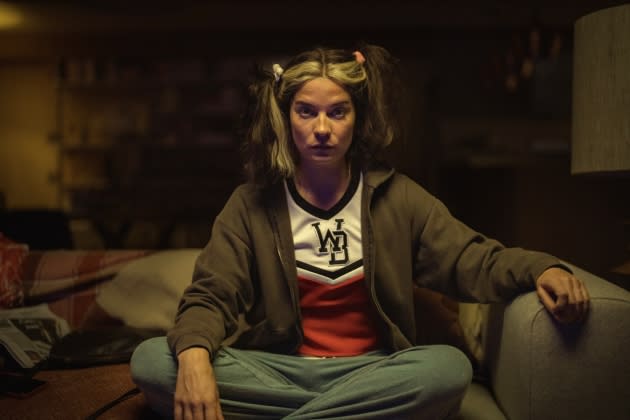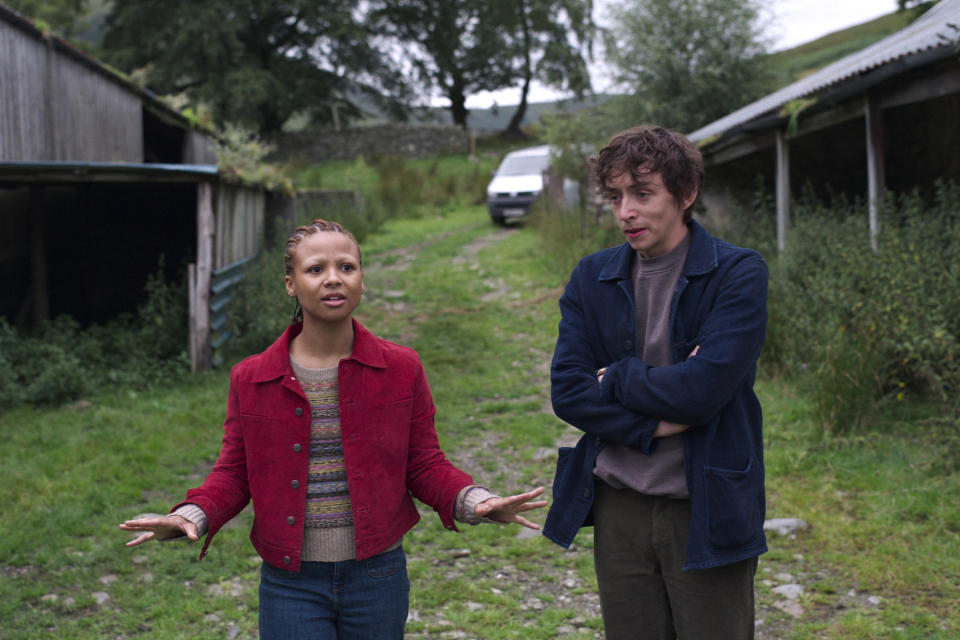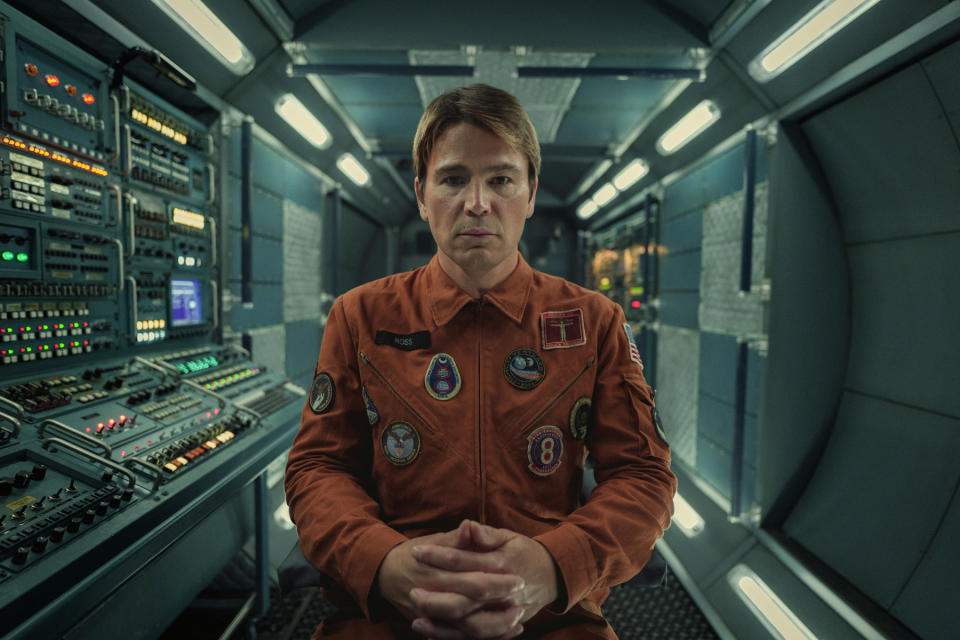‘Black Mirror’ Season Six Takes Aim at Netflix But Feels Stuck in the Past
- Oops!Something went wrong.Please try again later.
- Oops!Something went wrong.Please try again later.

This post contains spoilers for the sixth season of Black Mirror, which is streaming now on Netflix.
“Joan Is Awful,” the first episode of the new season of Charlie Brooker’s sci-fi satire anthology series Black Mirror, stars Annie Murphy as the title character, a tech-company executive horrified to discover that her life has, without her permission, been turned into a drama series on a streaming service called Streamberry.
More from Rolling Stone
'Star Trek: Strange New Worlds' Season 2 Is Remarkably Captivating
Our Ultimate Guide to the Best Streaming Services, Reviewed and Compared
'Never Have I Ever' Grows Up and Goes Away in Moving Series Finale
“Joan Is Awful” is notable for several reasons. First, it’s the best — or, at least, the best-structured — episode of the new batch. Second, it’s been a while since a Black Mirror comedy episode actually worked as a comedy, thanks to both its conceit — Streamberry has a supercomputer that can instantly adapt the events of Joan’s day into a TV show, using deepfakes of Salma Hayek and Himesh Patel — and the committed performances by Murphy and Hayek. Third, it is very much biting the hand that feeds it, since Streamberry is modeled in every way — including the logo font and the “tu-dum” sound that plays when people launch the app — on Netflix.
Perhaps most important, it’s the only one of these five new installments to really play around with the series’ chief areas of interest about our overreliance on new (or upcoming) tech. The second episode, the dread-soaked “Loch Henry,” is the only other one to be set in the present, and it’s set in such a remote part of Scotland that no one can get cell reception. The remaining episodes are in the pre-smartphone era, though “Beyond the Sea” takes place in an alternate version of 1969, where a pair of astronauts played by Josh Hartnett and Aaron Paul can kill time during their long voyage by uploading their consciousness into artificial duplicates that are back home with their families. “Mazey Day,” with Zazie Beetz as a paparazzo looking to make a big score involving a troubled movie star, is set in 2006, while “Demon 79” is set at the end of the Seventies. There’s still tech in all the others, but it’s all vintage: VHS tapes in “Loch Henry,” digital cameras in “Mazey Day,” and TV sets in “Demon 79.” And toward the end of “Loch Henry,” aspiring filmmaker Davis (Samuel Blenkin) becomes a celebrity when his story is turned into a popular Streamberry miniseries that looks and feels like every Netflix true-crime show you’ve watched since the start of the pandemic.
All of the episodes are interesting in different ways, even if “Joan Is Awful” is the only one that feels fully baked. But the totality of them is enough to make a viewer wonder if Charlie Brooker is growing tired of the show and/or his partnership with Netflix.
The former seems more likely, if only because Netflix has become such a huge digital part of our lives that it would almost feel disingenuous if Black Mirror didn’t take it on at some point. And the specific Netflix-oriented jokes in both “Joan Is Awful” and “Loch Henry” — including ones about the dangers of not reading the terms and agreements for any online service you use, and about how easily real people’s lives can be commodified in the never-ending search for streaming content — could apply to a host of other tech companies just as easily as they do to Netflix. But the series’ 2016 move from the U.K.’s Channel 4 to Netflix has been a mixed bag. It’s given Brooker and company access to bigger stars, and to a much broader and more expensive canvas. But these later seasons have been more uneven, in part because they’re longer than the three-episode runs produced for Channel 4.
The Netflix years have also been more repetitive, with a disproportionate number of them involving the perils of a person’s consciousness being transferred or duplicated into a device or virtual reality. This theme led to two of the show’s best-ever episodes: “San Junipero” (Gugu Mbatha-Raw and Mackenzie Davis fall in love in a digital version of the afterlife) and “USS Callister” (Cristin Milioti gets trapped in a tech mogul’s gross Star Trek-esque fantasy), but the more Brooker kept returning to the idea, the less impact each new iteration had.
So perhaps this latest season is just Brooker’s attempt to move away from what he’s done too much of in the past, and to neutralize jokes like Daniel M. Lavery’s old suggestion that every Black Mirror episode can be summed up as, “What if phones, but too much?”

If that’s the case, it’s admirable that Brooker isn’t simply resting on his laurels and trying to stretch the definition of what Black Mirror can be. But many of the new episodes fall victim to issues the series has been having for a while, even when it was focusing much more on social media.
[More serious spoilers follow. If you’re still planning to watch the season and want to know nothing, come back later.]
In particular, pacing and episode length remain big problems. Most of the Channel 4 episodes ran between 40 and 50 minutes, which felt about right to establish the rules of each twist on reality, tell a story about how tech harms the lives of these particular characters, and get out without overstaying your welcome. At Netflix, the new normal became 60 minutes, and often a lot more, to the point where it almost felt shocking when an episode like “Metalhead” (the black-and-white one with the vicious robot dogs) came in at only 41. Some of these installments take advantage of the extra time to dig deep on the characters and/or the concept, but many others feel like they’re repeating the same basic point over and over, just to be sure we get it.
“Beyond the Sea” and “Demon 79” are both well over an hour, and feel it, albeit the former more than the latter. Paapa Essiedu is so much fun as the titular demon, and Anjana Vasan from We Are Lady Parts is so good as the poor sales clerk who has to murder three people within three days to prevent the end of the world, that the lightness forgives some of the padding. “Beyond the Sea,” on the other hand, takes forever to set its plot in motion, when a group of Manson Family-ish hippies massacre Hartnett’s family and destroy his robot double, and then to work through the complications that ensue when Paul’s wife (played by Kate Mara) suggests letting Hartnett use Paul’s fake body on occasion as a break from his grief, and the monotony and isolation of space. Paul, Hartnett, and Mara are all very good, but the episode elongates every scene and story beat to the point where you may begin to feel like you’re the one stuck on a long-range space mission.

Ironically, the season’s shortest episode is the one most in need of extra time. At 40 minutes, “Mazey Day” is about the oppressive, debasing nature of paparazzi culture, and how it turns all of us into animals in some way. But the literalizing of the idea — where we find out that Mazey (Clara Rugaard) is not in rehab for a drug problem, but to hide her away during a full moon because she’s been turned into a werewolf — comes so far out of nowhere that it’s funnier (albeit unintentionally) than anything in either “Joan Is Awful” or “Demon 79.”
“Joan Is Awful” and “Loch Henry” make the most efficient use of their running time (each a shade under an hour). Joan’s discovery of this awful, life-ruining show, and then her attempts to find a way to cancel it, requires a gradual build, with each new complication creating a new joke. A particular highlight: Joan recognizes that she needs to do something so mortifying that Salma Hayek will object to her likeness re-creating it on the show, and crashes a wedding to spew diarrhea up and down the church aisle. (Murphy in that sequence is made up a lot like Margot Robbie as Harley Quinn. It works for the desperate and immature nature of the prank.) By the time Joan and Salma discover that they are actually characters in the version of the show that “Source Joan” is seeing in the real-world, and that there are now an infinite number of digital Joans, Murphy, Hayek and, in a cameo, Michael Cera are so amusing that it doesn’t matter that Brooker has once again played the simulation game. It’s also the rare Black Mirror episode that, like “San Junipero,” has a happy ending, as Source Joan finds greater satisfaction as a barista than she did as a middle manager, and is now friends with the real Annie Murphy.
The bulk of “Loch Henry” is a slow-burn mystery where Davis, his girlfriend, Pia (Myha’la Herrold), and his old friend Stuart (Daniel Portman) film a documentary about a serial killer who operated in Davis and Stuart’s hometown in the Nineties. The atmosphere is creepy, and the story unfolds at roughly the right pace to set up the twist that both of Davis’ parents were in league with the killer. The epilogue, where Davis discovers just how hollow nonfiction celebrity can be when it’s your own life being exploited, feels a bit rushed, but it also makes for an effective thematic one-two punch with the much sillier “Joan Is Awful.”
Unlike Joan, Brooker is unlikely to break free of the real equivalent of Streamberry. Another of his long-running U.K. projects arrived this year on Netflix with the latest hilarious Philomena Cunk mockumentary series, Cunk on Earth. The question is how much longer he wants to keep making his most famous series, and also whether his attempt to tweak the formula will extend beyond reducing the number of stories with iPhones in them.
Best of Rolling Stone

